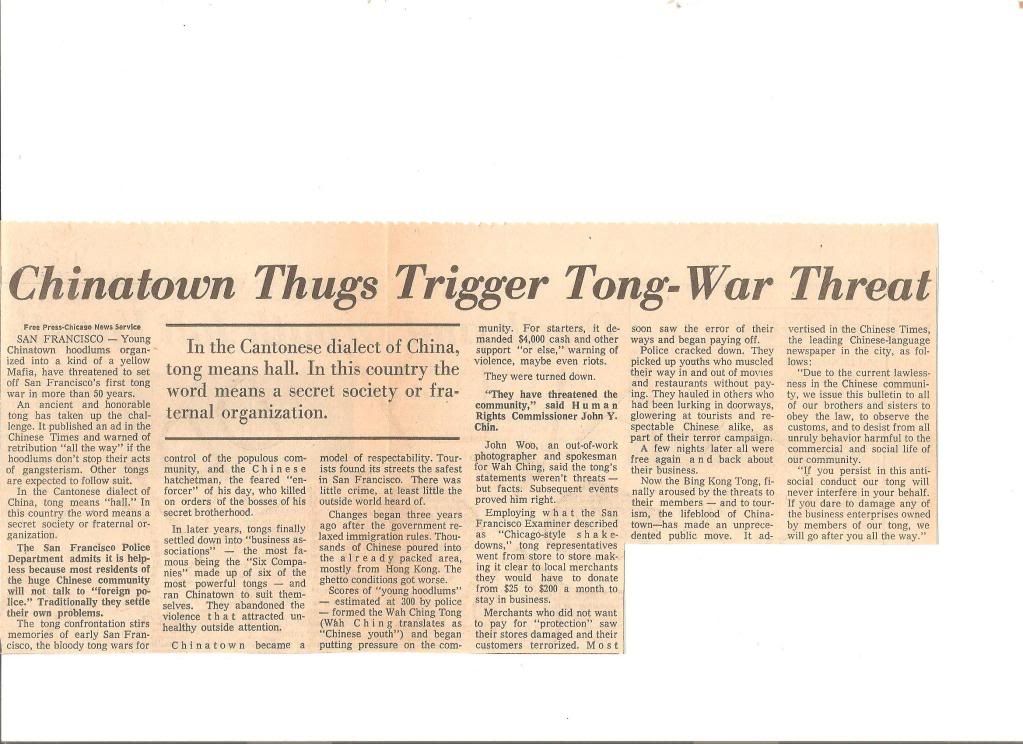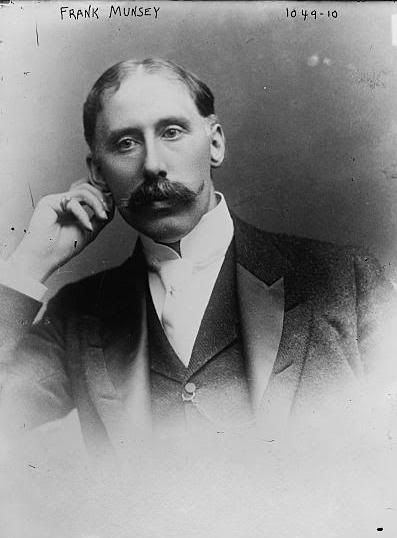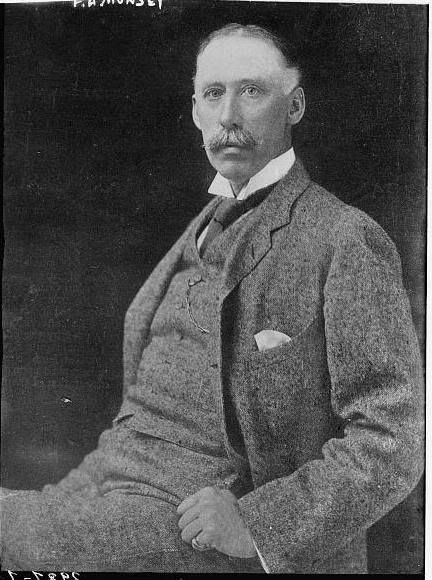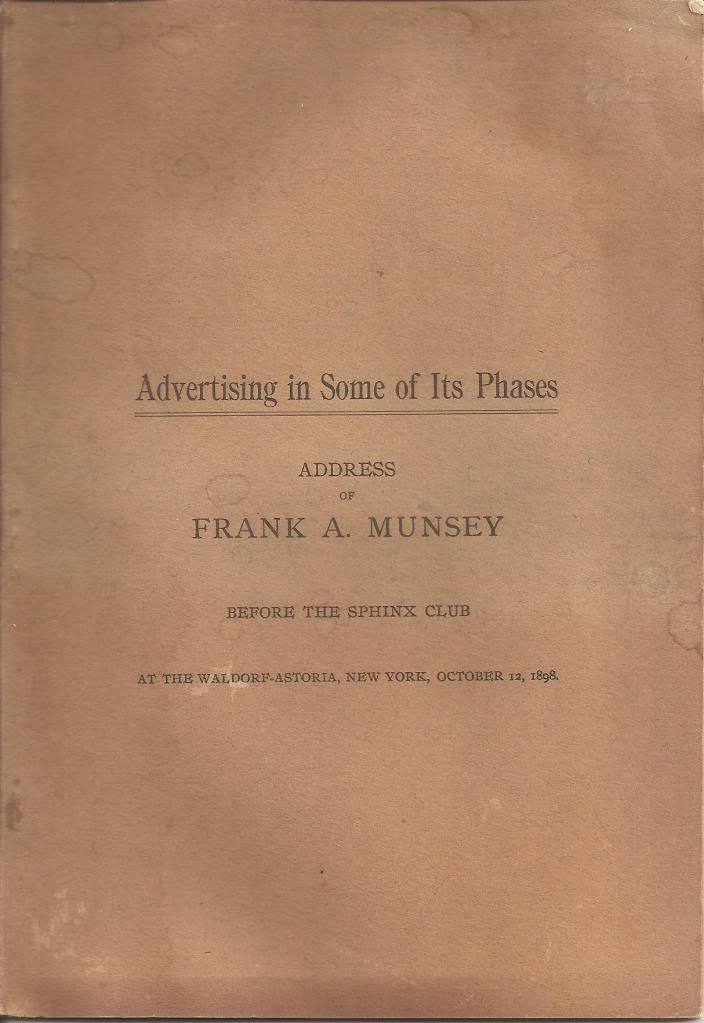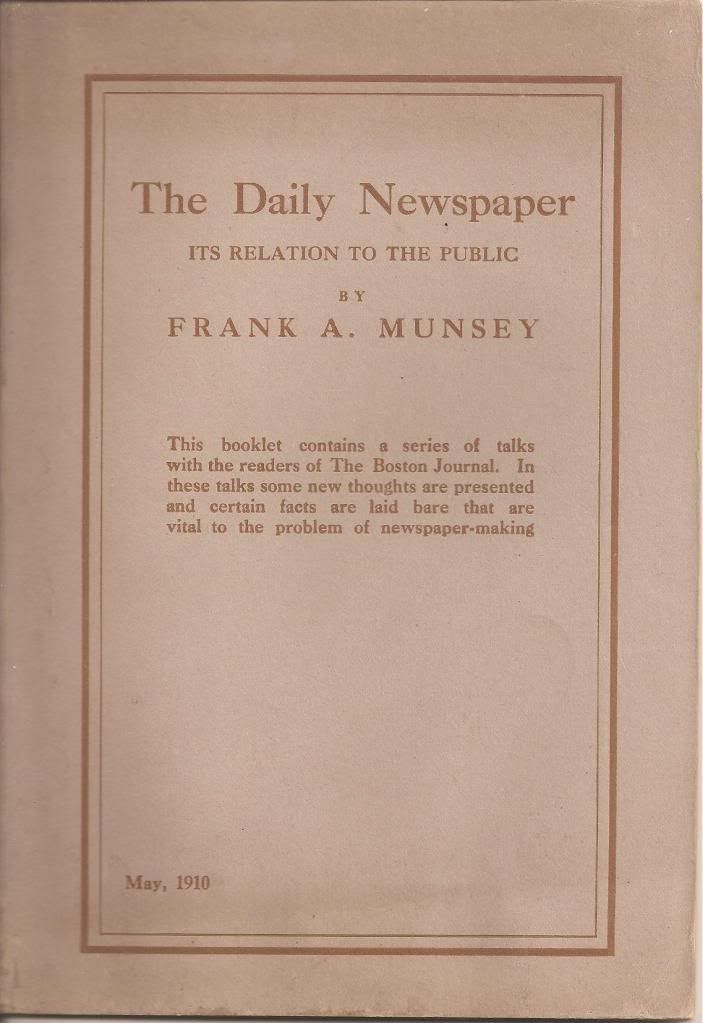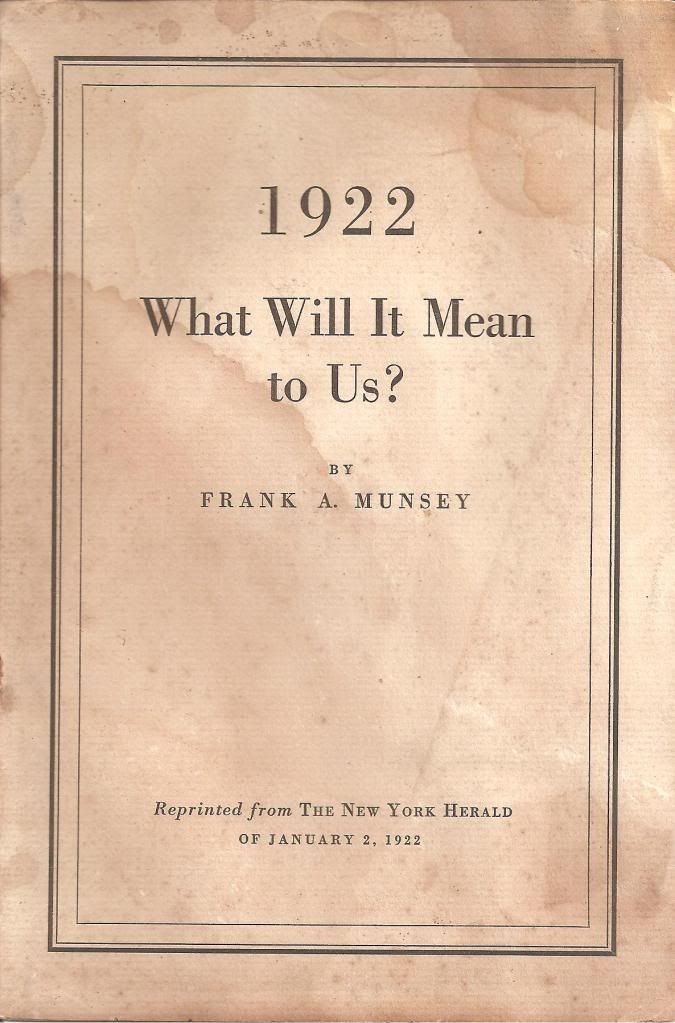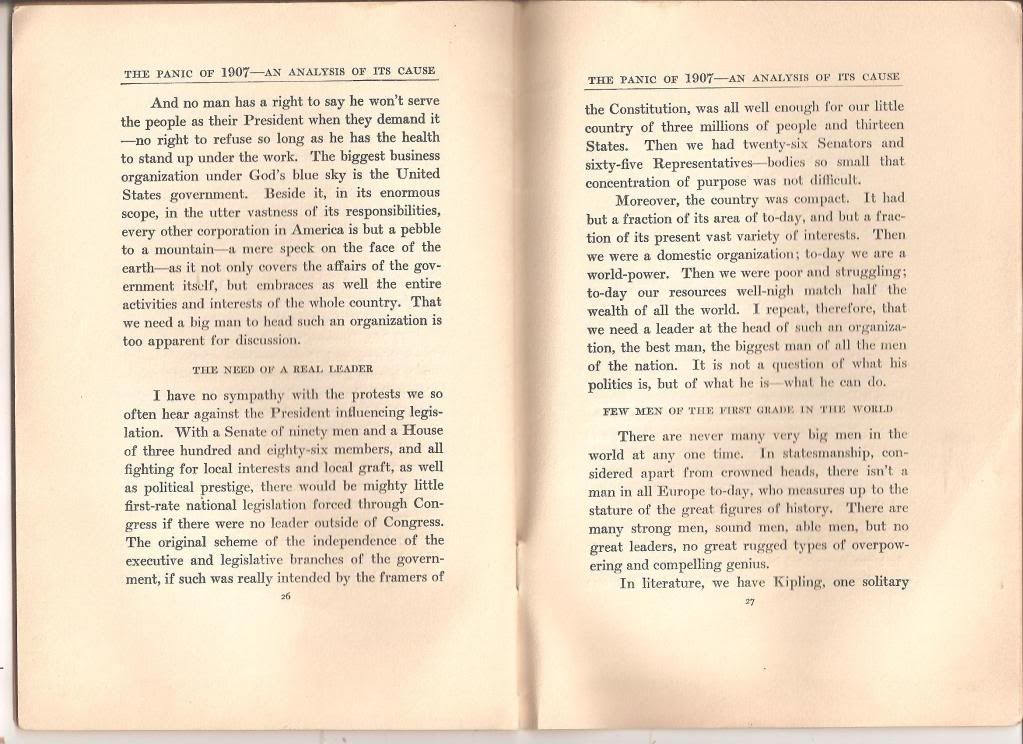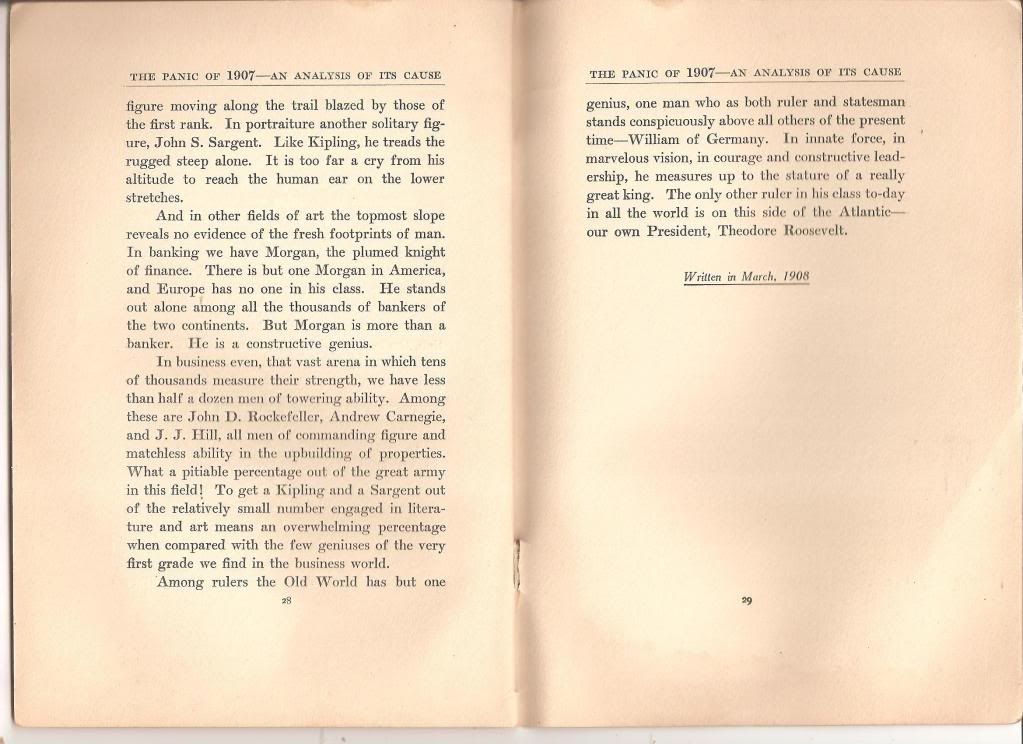My apologies for the amount of time between posts; the works of Burroughs are certainly engrossing, and can take up much more of one's time than is readily apparent.
Within this second entry focusing on Frank Andrew Munsey, I would like to go a bit more into the creation of his flagship title,
The Golden Argosy (although, according to Munsey himself, he always considered
Munsey's to be his most important publication). The primary sources I cite at the conclusion are of immense value in understanding the man; two, the viewpoints of historians of the publishing industry, and the other, from the pen of Munsey himself. Once again, I would like to stress that the following, truncated version of events should not be taken alone, and I implore you to seek out the primary sources listed, as they do more justice than I ever could.-
"And he began to tell me how he had carried on with the
Golden Argosy . . . how he had swamped himself with debts for print paper, printing, illustrating and stories. . . how he himself had written serials. . . "
Thus was the remembrance of Gilbert Patten, the man best known (under a pseudonym) for having created dime novel-staple Frank Merriwell, describing one of his encounters with Munsey at a journalistic club the two frequented. Munsey idolized Horatio Alger, Jr's stories of self-made men, and the creation of
The Golden Argosy follows a formula that could have been lifted from any one of Alger's tales; fittingly enough, Munsey biographer George Britt titled the chapter of his work in which the creation of the first Munsey publication is chronicled "Alger Story."
It was on September 23, 1882 that a twenty-eight year-old Frank Munsey, with only forty dollars in his pocket, first set foot in the bustling metropolis of New York City. Having left Augusta, Maine, with both promises of financial support and a determination to make his mark on the publishing industry, Munsey arrived in New York with very little to his name, and even less upon his person. With him was only a satchel containing, what he hoped, would be the foundations upon which to build his empire; several manuscripts, from a variety of authors, that he had bought using borrowed capital from various investors back home. "Do and Dare, or a Brave Boy's Fight for Fortune" was one of the stories Munsey had brought with him, penned by none other than Horatio Alger, Jr. himself. Despite financial setbacks, such as the unexpected removal of support from several promised backers (thus resulting in Munsey's only having forty dollars upon his arrival), the determined young man eventually sold the idea of his
Golden Days imitation to one E.G. Rideout, a printer of small standing in the city and, on December 2, the first issue of
The Golden Argosy was printed and distributed. Munsey himself, years later, wrote of the tribulations encountered by one attempting to craft an entire, ongoing periodical, more or less on his own:
"In the winter of 1886 I wrote my second serial story for
The Argosy, to which I gave the title 'Afloat in a Great City.' I have never worked harder on anything than I did on that story, to put into it elements of dramatic interest that would
get a grip on the reader. I wrote and rewrote the early chapters many times. It was midnight toil - work done by candlelight, after long days of struggle at the office."
Success was not immediate for Munsey, however, and several years of uncertain circulations and near-destructive financial setbacks threatened to sink the argosy to which Munsey had affixed his future. 1887 saw a sharp peak in sales, to be followed only by an equally steep decline. It was at this uncertain time, in 1893, between success and complete failure, that Munsey took a risk that not only forever changed the periodical industry, but also made him one of America's wealthiest men. The following is an excerpt from Munsey's eponymous title (the first issue of which was published in 1889), explaining this risk:
"These are the times when it is well to get down to bed rock - to get away down to the very substratum of things. At ten cents per copy and at a dollar a year for subscriptions in advance,
Munsey's will have reached that point, a point below which no good magazine will ever go, but to which all magazines of large circulation in America must eventually come. The present low price of paper and the perfecting of printing machinery make it possible to sell at a profit a magazine at these figures - as good a magazine as has ever been issued, providing it is not to heavily freighted with advertisements."
It was in cutting the price of his publications to ten cents (in addition to his use of cheaper, pulpwood paper) that Munsey assured his success. Most magazines of the time sold for more, anywhere from fifteen to thirty-five cents; Munsey sought to publish a periodical that could be afforded by the working-class readers of America, a demographic largely untapped by the "more sophisticated," pricier "slicks" of the era.
Munsey's was the first title to be lowered in price, followed by
The Argosy.
The Argosy (
"Golden" having been dropped some years earlier) was also undergoing fundamental changes; gone was the imitation of
Golden Days, the boys and girls weekly, and in its place, by 1896, existed what is considered by most to be the first pulp magazine. "I wanted to get
The Argosy wholly in a field by itself," Munsey later recalled, "So I worked out for it the plan of an all-fiction magazine, something brand-new - a type which it created, and which has since become one of the most successful in the magazine field." Munsey also decided to circumvent the major distributors of the day, companies that held something of a monopoly within the magazine industry. By selling
The Argosy, Munsey's, and later publications directly to dealers and newsstands, Munsey was able to sell his magazines cheaply, yet still make more of a profit than he would have had he collaborated with the distributors. According to Munsey, it was only after the largest periodical distributor in the nation approached him and offered to carry his magazines at a price of his choosing, that at "that moment I knew I was a millionaire." And, he was absolutely correct; by 1906,
Munsey's was selling 800,000 copies monthly, with
The Argosy following with 500,000. These numbers, combined with the circulation of several other Munsey titles such as
The Scrap Book and
All-Story, placed the totality of Munsey publications in circulation, in 1906, at over 2 million. The "Alger story" was complete, with advertising revenue mounting with each successful spike in circulation. Munsey had become as wealthy and as influential as any of the boy heroes whose exploits he had published in the earliest days of
The Argosy.
It was then that Munsey set upon the activities that would define him in the eyes of many historians: the constant buying, selling, shutting down and merging of various newspapers and magazines. Even the pulp magazines he created were not immune, as titles such as
All-Story Weekly and
Cavalier were, eventually, both folded into
The Argosy.
It is something of a shame that Munsey is remembered more as a destroyer of titles than as the creator of a medium; by the same token, however, it is not surprising. The histories of the publishing industries (histories that largely ignored the pulps) were written by those who saw no literary or creative value in the pulps, and, to a large degree, even in Munsey himself. "Cheap, inconsequential magazines" the author of Munsey's entry in the
Dictionary of American Biographies used in reference to
The Argosy and
other titles;
an insult against the man who, intentionally or not, created a medium that many cared deeply about, and continue to today almost a century after his death. The fact that the author understood nearly nothing about the subject matter is made obvious by the statement that Munsey was not "deeply interested in any causes:" simply put, one does not donate the monetary and advertising resources, as Munsey did for Roosevelt's 1912 presidential campaign, if one is aloof from any causes of great import. It is apparent, by such statements and others, that a dislike for the medium directly resulted in a dislike for the man. Not that Munsey's constant buying of titles (which often resulted in massive layoffs) did not play their part; rather, had it been a man not involved with what many deemed "trash" at the time (and, ignorantly, still do, to a large extent), it is likely that such harsh condemnations would not have been made. The vicious business practices he engaged in would not have been emphasized in later retellings, had the individual in question been someone other than Frank Andrew Munsey, the father of the pulp.
The next post will conclude this brief introduction to Frank Munsey, and will also contain the last few remaining scans concerning the "The Making and Marketing of
Munsey's Magazine." As always, I sincerely thank you for reading, and for your time.







 Sources
Sources
Britt, George. Forty Years – Forty Millions : The Career of Frank A. Munsey. Port Washington: Kennikat Press, 1972, 57, 81.
Goulart, Ron. Cheap Thrills - An Informal History of the Pulp Magazines. New Rochelle: Arlington House, 1972, 9.
Munsey, Frank Andrew. "The Story of the Founding of the Munsey Publishing-House," Munsey's Magazine. New York: Frank A. Munsey, Dec. 1907, 417- 423.
